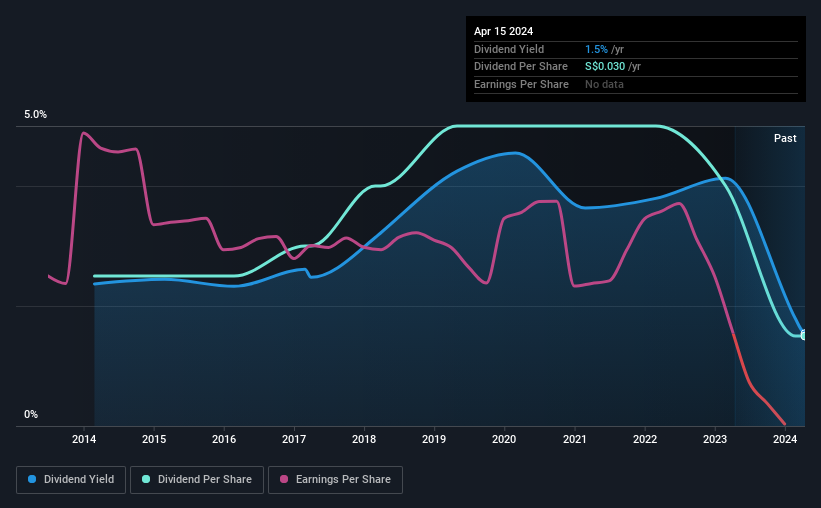Ho Bee Land (SGX:H13) Is Reducing Its Dividend To SGD0.03
Ho Bee Land Limited (SGX:H13) is reducing its dividend from last year's comparable payment to SGD0.03 on the 24th of May. This means that the dividend yield is 1.5%, which is a bit low when comparing to other companies in the industry.
Check out our latest analysis for Ho Bee Land
Ho Bee Land Might Find It Hard To Continue The Dividend
The dividend yield is a little bit low, but sustainability of the payments is also an important part of evaluating an income stock. Even though Ho Bee Land isn't generating a profit, it is generating healthy free cash flows that easily cover the dividend. We generally think that cash flow is more important than accounting measures of profit, so we are fairly comfortable with the dividend at this level.
EPS has fallen by an average of 29.9% in the past, so this could continue over the next year. This means that the company won't turn a profit over the next year, but with healthy cash flows at the moment the dividend could still be okay to continue.
Dividend Volatility
The company's dividend history has been marked by instability, with at least one cut in the last 10 years. The annual payment during the last 10 years was SGD0.05 in 2014, and the most recent fiscal year payment was SGD0.03. The dividend has shrunk at around 5.0% a year during that period. A company that decreases its dividend over time generally isn't what we are looking for.
Dividend Growth Potential Is Shaky
Given that the dividend has been cut in the past, we need to check if earnings are growing and if that might lead to stronger dividends in the future. Over the past five years, it looks as though Ho Bee Land's EPS has declined at around 30% a year. Dividend payments are likely to come under some pressure unless EPS can pull out of the nosedive it is in.
Ho Bee Land's Dividend Doesn't Look Sustainable
Overall, the dividend looks like it may have been a bit high, which explains why it has now been cut. In the past, the payments have been unstable, but over the short term the dividend could be reliable, with the company generating enough cash to cover it. This company is not in the top tier of income providing stocks.
Investors generally tend to favour companies with a consistent, stable dividend policy as opposed to those operating an irregular one. However, there are other things to consider for investors when analysing stock performance. Taking the debate a bit further, we've identified 2 warning signs for Ho Bee Land that investors need to be conscious of moving forward. Looking for more high-yielding dividend ideas? Try our collection of strong dividend payers.
Have feedback on this article? Concerned about the content? Get in touch with us directly. Alternatively, email editorial-team (at) simplywallst.com.
This article by Simply Wall St is general in nature. We provide commentary based on historical data and analyst forecasts only using an unbiased methodology and our articles are not intended to be financial advice. It does not constitute a recommendation to buy or sell any stock, and does not take account of your objectives, or your financial situation. We aim to bring you long-term focused analysis driven by fundamental data. Note that our analysis may not factor in the latest price-sensitive company announcements or qualitative material. Simply Wall St has no position in any stocks mentioned.

 Yahoo Finance
Yahoo Finance 
